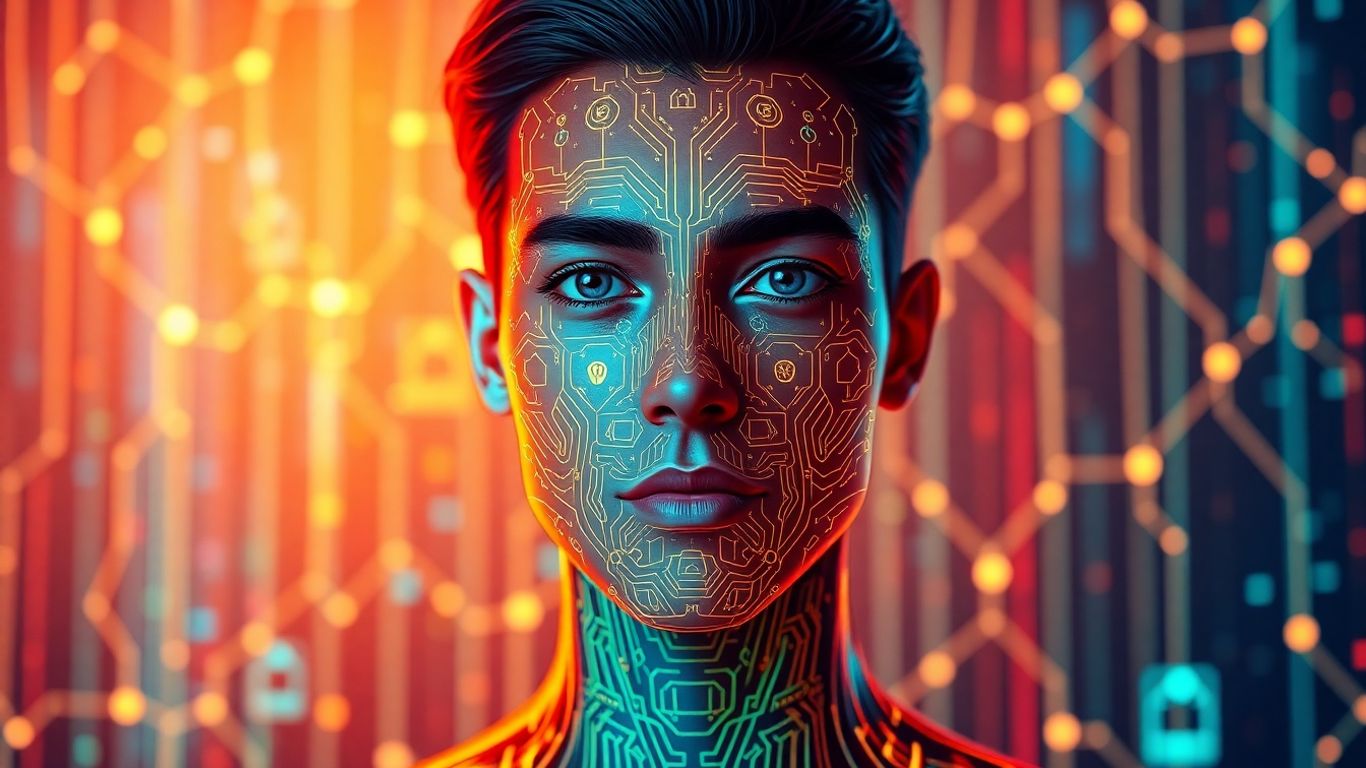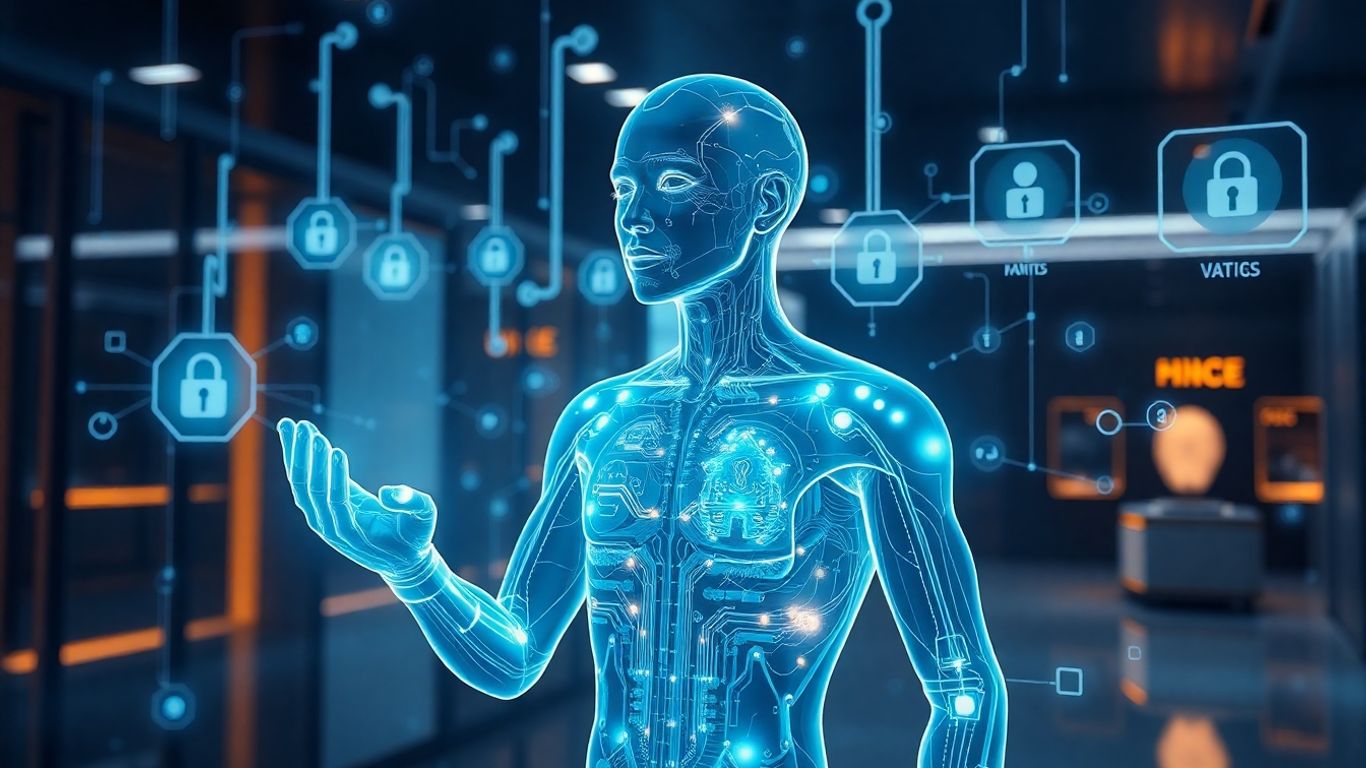[ newsletter ]
Stay ahead of Web3 threats—subscribe to our newsletter for the latest in blockchain security insights and updates.
Thank you! Your submission has been received!
Oops! Something went wrong. Please try again.
Explore how blockchain-integrated AI avatars are revolutionizing digital identity and security in 2025.





Digital identity is getting a serious upgrade in 2025. Blockchain-integrated AI avatars are changing how we prove who we are online, making things safer and a lot more user-friendly. Instead of juggling passwords or worrying about scams, these new systems use a mix of AI smarts and blockchain security to keep identity information both private and verifiable. The result? People have more control over their data, and businesses can trust the people they're dealing with. Let's look at what this means for digital identity and security this year.
AI avatars linked to blockchain tech have become much more than digital stand-ins—they’re full-on identity agents now. Instead of managing user profiles through a central server, these avatars combine blockchain’s open, unchangeable record-keeping with learning algorithms. This means your avatar can represent your identity anywhere online, holding the records, credentials, and verified proofs that define who you are.
Today’s leading AI avatars don’t just mimic a user’s appearance or voice—they securely handle authentication details, interact with apps, and store personal data using cryptographic keys. As a result, every digital move is logged and verifiable, helping cut down on identity theft and impersonation. Some companies, like those highlighted in the evolution of personalized digital experiences by Synthesia and HeyGen, are already showing the impact of AI avatars in real-world applications.
This new wave of digital identity relies on a simple mix of two big ingredients: machine intelligence and blockchain networks.
Key Benefits:
When your avatar can authenticate you with a face scan and log the session to a blockchain, lost passwords and fake profiles start to feel like problems of the past.
One of the blockbusters here is that you don’t have to trust one central authority anymore. Instead, your identity’s information is spread out, encrypted, and controlled directly by you—no single company or government holds all the keys.
Blockchains bring transparency, but you stay in the driver’s seat. In a world where user trust can make or break digital adoption, that makes all the difference.
Digital security looks a lot different now compared to just a couple years ago. In 2025, the rise of blockchain-integrated AI avatars has started to change how people and companies defend against scams, hacks, and account takeovers. AI agents now watch for dangers around the clock, while blockchain tech makes it possible to log, verify, and act in ways that are both trusted and super fast. Here’s how these new tools reshape digital security:
Today, relying on manual checks just doesn’t cut it. Blockchain-integrated AI avatars constantly monitor transactions, access points, and ledger activity for anything unusual. If something’s off—a strange login, weird contract behavior, or an attempted breach—these avatars can spot and respond within seconds.
Key security advantages:
These numbers highlight the vast difference between traditional audits and modern, AI-powered threat response.
Scammers and fraudsters keep getting trickier. AI avatars mix deep behavioral analysis with blockchain data, letting them flag suspicious actions instantly. Whether it’s a fake smart contract, a phishing attempt, or someone trying to drain a DeFi wallet, these avatars can lock things down or alert the owner before money is lost. AI will improve cybersecurity by picking up on patterns that humans might miss—like unusual transfers or contracts with hidden risks.
Here’s what real-time prevention looks like:
Instant and automated prevention stops most scams before they even reach the victim, making digital spaces safer for everyone.
Mistakes still happen. But now, blockchain-integrated AI avatars link up with digital insurance pools and offer quick response plans.
With these improvements, even if a breach slips through, users have a clear path to recovery, confidence in getting help, and less fear about catastrophic loss.
In short, blockchain-integrated AI avatars are taking the stress (and guesswork) out of digital security. Automated monitoring, instant scam blocking, and safety nets for victims show this tech is finally catching up to the real threats out there.

AI-powered blockchain identities are solving the big privacy headache online. Zero-knowledge proofs (ZKPs) are a breakthrough here—they let you prove your identity, age, or credentials without sharing the actual details. It’s pretty wild: You can show you’re over 18 or have a valid driver’s license without exposing your name, address, or ID number.
This kind of privacy technique is changing online verification by making data collection almost unnecessary.
Some highlights:
People don’t have to sacrifice privacy for convenience anymore—ZKPs finally offer both, with a bit of technical magic under the hood.
The days when huge companies owned all your digital identity might be ending. With self-sovereign identity (SSI) powered by AI avatars, people own and manage their credentials. These avatars automatically aggregate, verify, and present credentials without giving third parties unnecessary access. Here’s how the new model stacks up:
AI avatars help users:
Self-sovereignty means you control your identity, not some faceless company. It’s a big shift from the old days, and AI avatars are the practical, everyday face of this change.
Having control over your personal data isn’t just a buzzword—it’s happening in real products now. Blockchain-integrated AI avatars put the decision back in your hands. Think of it this way: You no longer just sign up for a site and give it everything. Instead, you get these options:
The ability to review, update, or remove shared data across platforms makes privacy and control the norm, not the exception.
With AI avatars, controlling your identity feels way less stressful—kind of like switching from dozens of fiddly passwords to just unlocking your phone with your face. Everything gets simpler, safer, and more transparent.

Blockchain-integrated AI avatars are making digital identity management something anyone can handle—not just techies. Instead of juggling endless logins, worrying about privacy leaks, or struggling with accessibility, these new avatars are building a smoother, safer, and more inclusive experience.
Nobody loves passwords. Now, with AI avatars backed by blockchain, a single digital profile can get you everywhere you need to go online. That means less time spent resetting passwords and more time actually using services.
Having one secure digital identity isn’t just convenient—it brings peace of mind, making sense of the online chaos.
Many folks are shut out of digital services because of complex logins or inaccessible design. Blockchain-integrated AI avatars can break these barriers by offering:
This approach is changing who can participate in the blockchain and digital innovation wave—not just Silicon Valley insiders.
AI-powered avatars can verify your identity anywhere, whether you’re logging into a bank or joining a new social platform. Consistency across services reduces headaches and risks:
By rethinking identity with blockchain and AI, 2025 is seeing a digital landscape where managing who you are online is finally catching up with how people actually live and work.
Meeting regulatory expectations in 2025 is nothing short of a balancing act. Blockchain-integrated AI avatars are making it easier to handle complex compliance requirements. These digital avatars perform automated checks for GDPR, CCPA, and similar standards, reducing the human workload and the chance of something slipping through the cracks.
Compliance is now a process that's monitored in real time, not just checked off during an annual review.
The smart use of AI and blockchain together means digital identity systems are finally becoming more adaptable, less stuck in a single regulatory model.
AI integration with blockchain is paving a smoother road for both compliance and innovation in industries that were once too risky for digital transformation.
In high-risk fields like finance and insurance, blockchain-based AI avatars are always on watch. They monitor transactions, spot new fraud trends, and evaluate risk on the fly.
Some common practices:
Threats move quickly, especially when high-value assets or regulatory oversight are involved. Blockchain-integrated AI avatars are turning digital identity management into a cooperative effort, bringing law enforcement, compliance teams, and private analysts together without having to share sensitive data.
Key ways avatars improve forensic response:
Investigations that might have dragged on for weeks can now wrap up much faster, with more confidence in the findings and less room for mistakes.
The bottom line? High-risk industries aren't just reacting to threats anymore—they're finally outpacing them thanks to these new digital tools.
Digital identity in 2025 isn't working in isolation—it's all about connecting different technologies and services in ways that were just wishful thinking a couple of years ago. Blockchain-integrated AI avatars are now at the center of this movement. Composability lets digital identities work seamlessly across different platforms and applications, whether they're DeFi wallets, health records, or IoT devices. The result? Less friction for users, faster verification, and reduced risk of data silos.
A quick table of how digital identity composability is showing up in practice:
There’s also a strong push for more open standards and interoperability—meaning your digital ID should work almost anywhere, regardless of which blockchain or provider you started with. This link between AI, blockchain, and new identity services offers better control, quick onboarding, and improved access for all kinds of users, as noted in AI-enhanced blockchain security.
Quantum computing is no longer sci-fi; it’s creeping closer to reality. With its rise comes a real risk: current cryptography can be broken—fast. Blockchain-integrated AI avatars are expected to transition to quantum-resistant cryptography, helping users and organizations stay a step ahead of bad actors.
Here’s what’s already underway:
Just as AI and automation have made audits and identity verification faster, they’ve also fueled new kinds of attacks. Phishing and deepfakes now use AI models to mimic voices and faces. Cross-chain bridges and interoperable protocols mean a single breach can have widespread effects.
A few challenges organizations and individuals are facing right now:
Digital identity in 2025 looks promising, but there’s no universal fix for threats or regulatory ambiguity—constant innovation and collaboration are still needed to keep ahead.
As identity services become more automated and open, expect steady gains in security and accessibility—but there’s no coasting. The ecosystem keeps moving, and robust, AI-powered blockchain tools will stay essential for both safety and a smooth user experience.
Blockchain-integrated AI avatars have started to take on big roles in business operations. Enterprises use them to verify identity, reduce fraud, and build new layers of digital trust. By combining automation with transparency, these avatars help companies work faster, more securely, and with fewer human errors.
AI avatars backed by blockchain give companies a secure way to manage digital identities:
Many businesses now choose to run their entire identity management process through automated AI avatar layers, which are synced to the blockchain for real-time transparency.
Using decentralized AI-based identity platforms, organizations are able to focus on their core operations, knowing identity and compliance processes are both automated and auditable.
Fraud and identity theft were expensive headaches in the past. In 2025, blockchain-integrated AI avatars help tackle these challenges:
Blockchains are often siloed. AI avatars with interoperable credentials break down these barriers for enterprises:
Interoperable AI-driven credentials mean less busywork for compliance teams and less risk of outdated or fake profiles entering your business network.
In short, these new digital identity systems do more than replace old paperwork—they make businesses faster, safer, and more flexible. The competitive edge comes from moving to systems that prevent fraud and enable instant, trustworthy exchanges between every party involved.
So, where does all this leave us? Blockchain-integrated AI avatars are quickly changing how we think about digital identity and security. Instead of juggling dozens of logins or worrying about who has your data, these new systems put you back in control. AI avatars can spot scams, flag risky contracts, and even help recover assets if something goes wrong. And with everything recorded on the blockchain, there’s a clear trail that’s tough to fake or tamper with.
It’s not perfect—no tech ever is—but the progress in 2025 is hard to ignore. Early-stage projects and regular users now have access to tools that used to be out of reach. Security checks are faster, cheaper, and more reliable. The community is more involved, and there’s a real push for transparency and fairness. As these tools keep improving, it’s likely we’ll see even more creative ways to protect our digital lives. For now, blockchain and AI together are making the internet a safer place to be yourself.
A blockchain-integrated AI avatar is a digital version of yourself that uses artificial intelligence and blockchain technology to manage your online identity. It helps you prove who you are online, keeps your information safe, and gives you more control over your personal data.
AI can spot threats and strange activity quickly, while blockchain keeps your identity information secure and unchangeable. When combined, they make it much harder for hackers or scammers to steal your identity or trick you online.
Yes, these avatars use smart AI tools to watch for scams, fake websites, and other dangers. If something suspicious happens, the system can warn you or even block the threat right away, helping to keep your digital identity safe.
Yes, one of the main goals is privacy. You control what information you share and with whom. Advanced privacy tools, like zero-knowledge proofs, let you prove things about yourself without revealing all your details.
These systems are being designed to be simple and user-friendly. They aim to make logging in, verifying your identity, and managing your information easy—even if you’re not a tech expert. They also help people around the world, including those who might not have access to traditional ID systems.
Businesses can use blockchain-integrated AI avatars to quickly and safely check who their customers are, reduce fraud, and make onboarding new users much faster. This builds trust and saves time and money for both companies and users.


